100th General Hospital Unit History
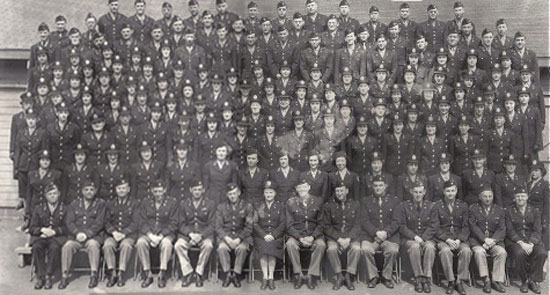
Group photograph showing Officers and Nurses of the 100th General Hospital. This picture was taken in March 1944 during the unit’s time at Cp. Kilmer, New Jersey.
Activation & Training:
The 100th General Hospital had originally existed during WW1 as Base Hospital No. 100. Having been demobilized at Cp. Sherman, Chillicothe, Ohio, Base Hospital No. 100 was finally re-organized on 25 June 1943 as a result of Order AG 320.2 (dated 27 March 1943) as the 100th General Hospital at Fort George G. Meade, Baltimore, Maryland (AGFRC). A document would follow some months later detailing 30 Enlisted Men from the 127th General Hospital to permanent duty with the 100th. Colonel Sam F. SEELEY became the Commanding Officer of the unit in early 1943, and by the summer of the same year had organized the majority of administrative staff for the Hospital. The majority of the personnel were at this point mainly new Officers, who had only recently completed the necessary courses at Officer Candidate School (OCS).
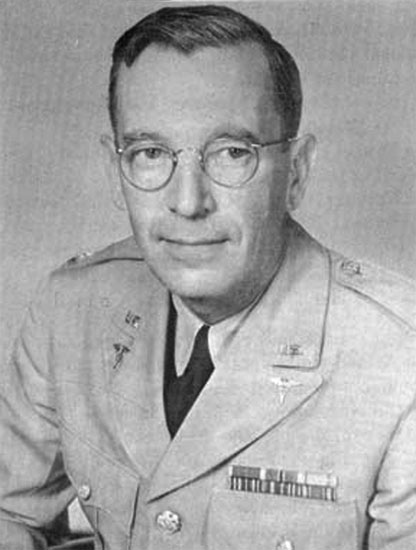
Col. Sam F. Seeley, Commanding Officer of the 100th General Hospital.
A few of the Enlisted Men that had been assigned to the 100th Gen Hosp were selected for advanced training in order to bring the unit up to T/O strength. While there was somewhat of a delay in organizing the necessary personnel to make this possible, the majority of the first batch of Enlisted Men for the Hospital had reported for duty by 15 July 1943 (most men came from Cp. Grant, Illinois and Cp. Pickett, Virginia). The remaining period of 1943 was devoted entirely to training under MTP 8-10. The training was completed on 28 November 1943 and the unit experienced difficulty in applicatory training of its personnel. In an effort to remedy the situation, the 100th was transferred to Fort Dix, Wrightstown, New Jersey (Training & Pre-Staging Center) on 22 December 1943, where it was attached to Tilton General Hospital for supplemental training and preparation for overseas movement. During this time, additional Officers and Nurses joined the unit and it was completed to T/O strength on 14 February 1944.
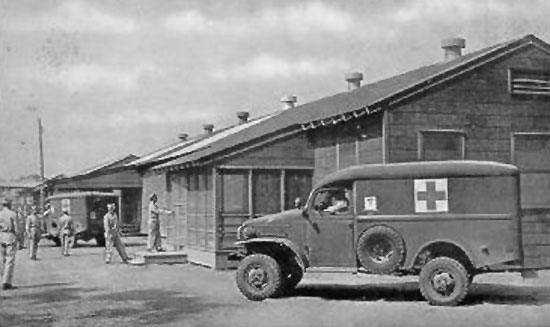
Photograph taken early in WW2, showing the Hospital section of Cp. Kilmer, NJ. Of special interest is the 1/2-ton 4 x 4 Field Ambulance in the foreground.
The unit finally received orders to active duty overseas in March 1944, and was moved to the New York Port of Embarkation. In the interim however, personnel from the organization spent 23 days at Camp Kilmer, Stelton, New Jersey (Staging Area) which, unlike other periods at US Army Camps, was actually spent doing very little, besides the usual EM recreational activities. Enlisted Men were restricted to the post, while Officers and Nurses received 72 hour passes. Roll calls were made every morning, and the EM Company (under Lt. William Hamilton) established makeshift card and craps tables for entertainment. Finally, on 8 April 1944 all of the personnel of the 100th GH boarded RMS “Aquitania” at the NY P of E for the trip across the Atlantic.
Overseas Movement:
RMS “Aquitania” was a British ship that had been converted from a WWI Hospital Ship (“Aquitania”) and then into a luxury cruise liner for the Merchant Navy. At the outbreak of WW2, the ship was converted once again into a Troop Ship configuration. With the 100th General Hospital personnel on board, the ship crossed the Atlantic to the British Isles “naked” (i.e. without protection from the US Navy or Coast Guard). It was during the first hours on board the ship that many members of the 100th received their first medical procedures in the Army; issuing “overseas shots” to those passengers that had somehow been overlooked by the port staff.
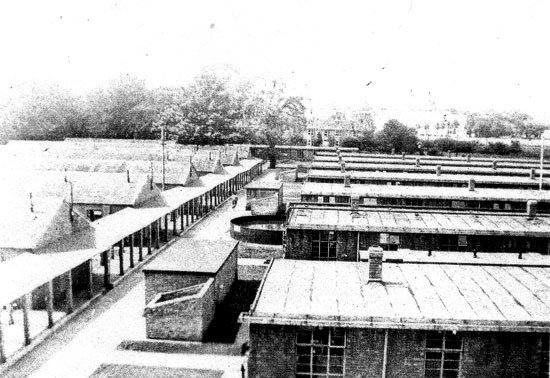
Bricked buildings used as wards during the 100th General Hospital’s time at the Frenchay Park facility, Bristol, England.
The “Aquitania” finally docked in Greenock, Scotland on 14 April 1944. Upon disembarkation, the staff of the 100th General Hospital was conveyed 18 miles to the railroad station situated in the suburbs of Glasgow where it boarded a troop train which transported the personnel the 275 miles to its next destination in Colwyn Bay, North Wales. The train arrived late on the same day, and the Hospital personnel were assigned temporary billets in civilian homes that had recently been vacated by other US troops. The stay in Colwyn Bay was relatively short, and the unit was once again on the move on 16 May 1944 for the Frenchay Park facility, 175 miles away in Bristol, England. The 100th was assigned to exchange assignments with the 298th General Hospital which had been operating at Frenchay Park for 20 months prior to the 100th GH’s arrival. The transition of personnel at the Frenchay Park Hospital was seamless to the 350 patients who were being treated at the hospital plant when the 100th arrived, and was finally completed in preparation to receive casualties from the landings in France.
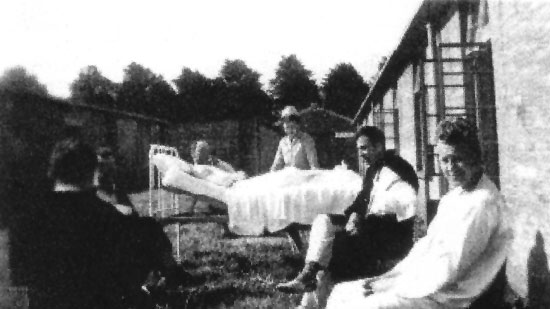
American patients convalesce at the Frenchay Park Hospital, tended to by a 100th GH Nurse.
Col. Sam F. Seeley then invited HRH Queen Mary to visit the Frenchay Park facility and see the work of the “Century Hospital”. Interviews with surviving members of the Enlisted Men pertaining to the unit in 2001 however, seem to indicate that some of them were unaware of this Royal visit.
The twelve-week operation at Frenchay Park proved to be invaluable to the unit. The patient load was sufficiently heavy prior to D-Day to afford ample opportunity to apply the training which had been received, thus bolstering the confidence of the personnel. During its time at the facility, the 100th General Hospital treated a total of 3250 patients, 509 of whom were returned to the ZI for further treatment and convalescence, while 1076 were turned over to the 117th General Hospital that replaced the unit at the Frenchay Park Hospital.
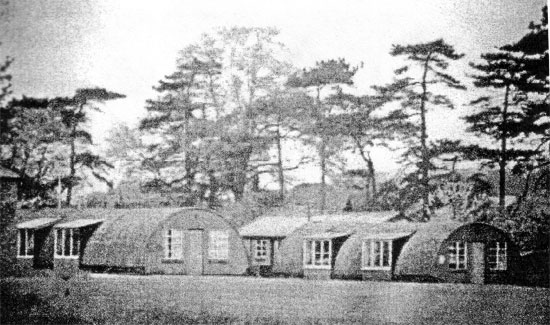
EM barracks at Frenchay Park. This photograph was actually taken in 1966, although nothing remains of the buildings today.
It was in August that the 100th prepared their move to France, first being transported to Brockley Hall Camp on 4 August 1944, and then finally on to a staging area at Moorhill Camp, Southampton on 18 August. The unit remained in the camp for only 48 hours, at which point it was finally moved to Southampton where all personnel were loaded aboard the SS “Léopoldville” at approximately 1330 hrs on 20 August. This ship would later be sunk in the English Channel by a U-Boat attack. Despite almost running aground in the artificial shallow water wharfs, Higgins Boats were used to ferry the 100th personnel, along with other American forces to Utah Beach. From there, the troops of the Hospital made their way five miles inland to a predetermined bivouac area, which they were to reach before dark on the same day (22 August 1944).
First Operations in the ETO:
The field in which the 100th General Hospital Officers and Enlisted Men found themselves for their first night in France was an apple orchard at St.-Germain-de-Varreville. The orchard was in the area of the Airborne DZs and remnants of the invasion were still visible no more than two or three hedgerows away from this location. The personnel of the Hospital (Officers and EM) were living in Shelter Halves, and using the slit trenches which had been dug by the personnel as latrines. The unit departed the area at around 0400 hrs on 4 October 1944 for their new destination in Paris.
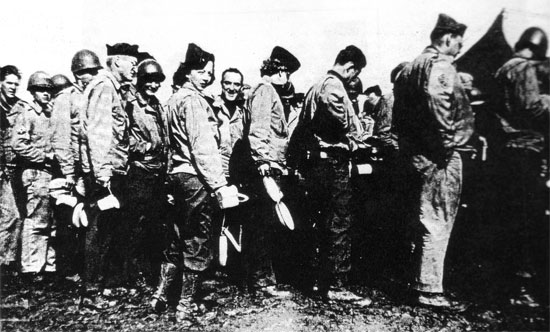
Officers, Nurses and Enlisted Men alike wait in line to be served chow during the unit’s stay in the French cow pasture, awaiting relocation to Bar-le-Duc.
The journey to Paris took almost 5 days, and many of the personnel claim that this was a journey via railroad in very uncomfortable conditions with periodic sanitary stops. The 100th finally arrived in St. Lazare, a suburb of Paris on 8 October, and trucks were already waiting to take its personnel directly to Le Bourget airfield. Some of the staff managed to obtain passes and transport into downtown Paris, but this was only reserved for the lucky few. Those that remained at the airfield were assigned Temporary Duty to one of the numbered General Hospitals that had been set up in a French civilian hospital in another suburb of Paris (Chantilly).
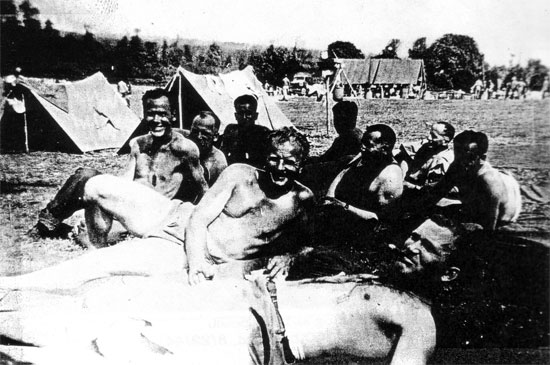
NCOs of the 100th General Hospital enjoy the Norman weather before being moved to Bar-le-Duc.
It had originally been thought that the 100th would be assigned permanently to a French hospital in Paris. However, the Armies were advancing so rapidly that the unit was ordered to Reims where it was to take over an American hospital, mostly destroyed in WW1 but, later during the 1930s, restored by the French-loving American Rockefeller family. Unfortunately the exact date of this take-over is unknown, and it is thought that only the Advance Party of personnel went to Reims, and only then for a matter of only a few days, before being relocated to Bar-le-Duc.
The Advance Party of 25 personnel arrived at Bar-le-Duc prior to the entire unit’s arrival. Again, there are conflicting reports as to the specific dates of which the bulk of the personnel arrived at the 19th Century French Cavalry casernes which the 100th GH was to take over. However, it would seem that the Operating Room already became fully operational on 10 November 1944, while US Army Engineers were still working on the buildings which had been devastated by the retreating German Army. Testimonies from Veterans indicate that the Hospital had been operating partially, prior to this date. The following is a transcript taken from the memoirs of Captain Adolph M. Wolff, 100th General Hospital, describing briefly the layout of the hospital at Bar-le-Duc:
(The US Corps of Engineers came in and turned the various buildings into a 1,000 bed, fully equipped General Hospital, with quarters for all to sleep in “comfortably.” Three of the Colonels had a small house for themselves on the walled compound. The second Looies [2d Lieutenants] were quartered mostly on the third floor of a building which had no “modern” bathroom facilities.)
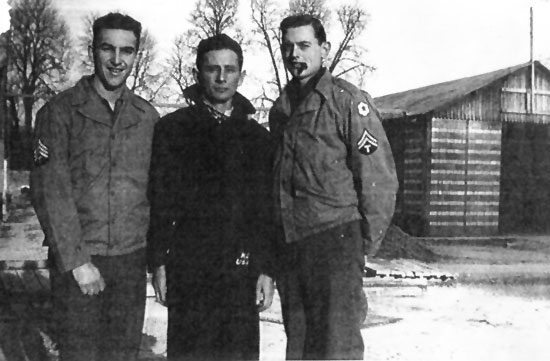
Two NCOs of the 100th General Hospital with a patient. Photograph was taken somewhere in Bar-le-Duc during the winter of 1944. Note the patient wears a maroon corduroy Bath Robe.
A great number of German PWs were assigned to the Hospital during this time and were responsible for some of the daily menial tasks. By the end of 1944, 3248 patients had been admitted to the 100th Gen Hosp, the majority having been received during the time in Bar-le-Duc. Continual improvements were made to the various casernes that made up the complex, and the two main buildings that comprised the area were assigned specific roles. One half was dedicated to the care of patients, while the other was used for living quarters of Hospital personnel and recreation areas for them.
Despite the best efforts and improvisations however, severe problems still existed with the buildings in which the command was operating. For example a four storey building that was being used as a ward had sewage from the uppermost storey flooding down to the ground floor. In addition, shower fixtures flowed continuously and toilets would either flush hot water, or not at all. Realizing that such conditions would soon become a major problem, the 6th Engineer Special Brigade was ordered to repair the various problems, and working alongside the 372d Engineer General Service Regiment (activated 20 December 1942, embarked for England 14 August 1943 –ed) were able to furnish basic flushing latrines and working showers. Gradually, improvements were also made to troop quarters and mess halls were moved from unlit barns to compact, clean buildings. One final addition worthy of note is the bridge that was constructed over the neighboring river, giving permanent access to the 95th General Hospital which was located in close proximity to the caserne, along with the 98th General Hospital. All three of these Hospitals would later help to form the 819th Hospital Center.
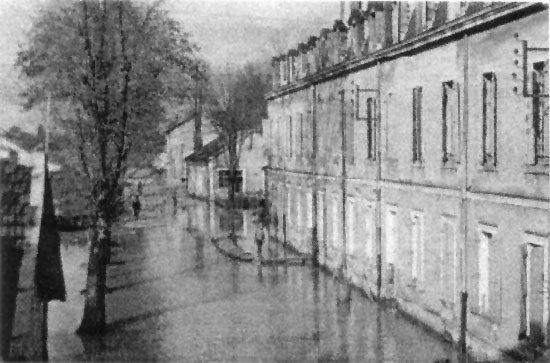
Nurse quarters at Bar-le-Duc on the right. Note the flooded road and hanging lyster bag in front of the buildings.
Since the supply of distilled water (for the reconstitution of desiccated plasma) was low, two Technicians from the Hospital constructed a still. These two men were T/4 Ralph Nurnberger and T/5 Joseph Itatesta, who constructed the machine from discarded medical supplies.
Command Changes & Statistics:
Shortly before 1 January 1945, the 819th Hospital Center had been organized with its Headquarters in Bar-le-Duc, and since the 100th GH was deemed as having been specially equipped, it was designated as the Neurosurgical, Urological and Ophthalmosurgical Center of the area. This formation however meant a change of staff and administration. Colonel Sam F. SEELEY assumed command of the Hospital Center and also took Chief Nurse, Major Cleta Gahagan, Major Gahagan (being replaced by her Executive, 1st Lt. Sheddan) and Captain Ronald E. Bowen, Dental Officer along. In his place, Lt. Colonel Storer Humphreys was assigned as Commanding Officer to the unit. A matter of only months later, the unit’s Executive Officer, Lt. Colonel Harry W. Woolldhander was also lost, this time through illness and so the position was assumed by Lt. Colonel Arthur C. McCarty, then Chief of Medical Service; a role which he continued while serving with the 100th.
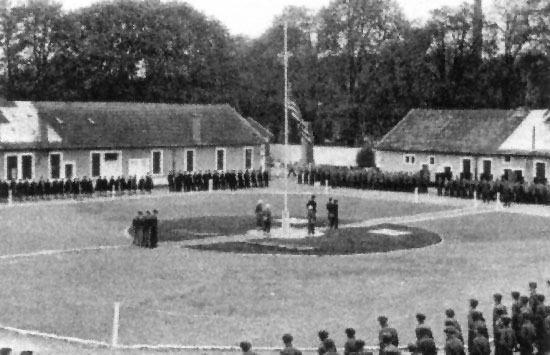
Flag lowering on Bush Square of the 100th General Hospital (Bar-le-Duc) for the death of President Franklin D. Roosevelt. Photograph taken 12 April 1945.
From 1 January to 8 May 1945, the Hospital handled a total of 7695 patients, a figure which would rise to 8339 less than a month later. Although it had officially been given the designation and T/O & E of a 1000-bed unit, during times of stress it was expanded to a total of 1701 beds, and during its busiest time had 1636 patients in its beds.
After considerable difficulty with administration of evacuation, the 100th General Hospital developed a unique system of reporting the evacuation status of its patients which proved to be a great success on all counts. The evacuation status of all patients was handed over to the Ward Officers who were responsible for updating the “Evacuation Status Board.” This was a board measuring 3 feet x 2 feet that was placed on each ward, and divided into columns used to indicate a patient’s status. The system proved so effective, that the R&E Department were able to tender 304 patients (admittances and evacuations) in only 120 minutes.
Throughout the winter and spring, many Medical Officers were lost to the command, first as the younger ones were withdrawn to fill in at Aid Stations along the front, then after D-Day, when they were taken, irrespective of age or rank, to complete staffs of other Hospital units. Three more returned to the ZI due to poor health, and one Officer died while on active service with the Hospital. For its loss of fifteen Officers, only 10 replacements were received and at times, the load was extreme. However, the greatest loss to the unit in 1945 came in the Enlisted Men. In total, 127 EM were lost; 120 were sent to up to frontline units as infantry replacements, and 7 were promoted to the rank of Second Lieutenant and sent to other Hospital units in the area. Only ninety nine replacements were sent to the 100th for the loss of its enlisted personnel.
With the loss of Captain Theodore B. Holstein in February, Major Robert L. Pulliam, Sr. assumed the duties of the ophthalmic surgeon in addition to his previous assignment of ear, nose and throat surgery. Refractions, treatments and minor surgery were done in the EENT Clinic, and major surgery in the Operating Room. A five-room clinic was developed, and various types of work allocated for greater efficiency.
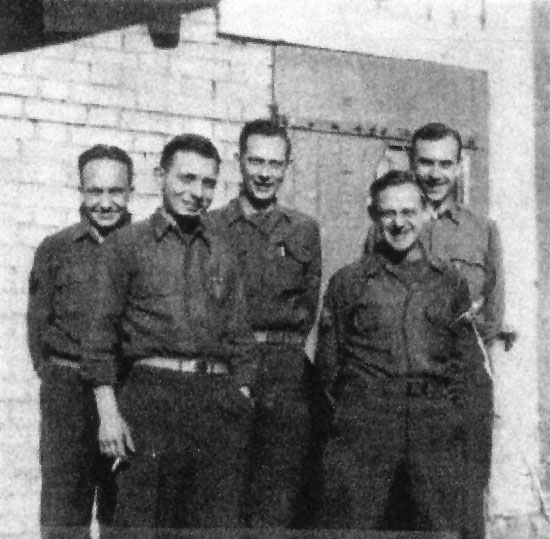
EENT Clinic personnel during their time at Bar-le-Duc. From left to right:
T/5 Lynn O. Winget
Pfc. Elmer K. Miller
T/Sgt. Charles R. Junkins
T/4 Jacob Ackerman
Maj. Robert L. Pulliam Jr.
The Chaplain Department was led by the Chaplain, Captain Samuel R. Glenn. Services were arranged by Glenn and his staff for Catholic, Protestant and Jewish personnel and ambulatory patients, and this did a great deal to maintain the equanimity of all. Among his other duties, Glenn also assisted patients in writing letters.
Since the command of the 100th was keen to preserve trained personnel for specialized tasks and responsibilities, a great number of local inhabitants and PWs were used within the hospital grounds to perform tasks necessary for the daily deportment of the unit. French civilians were hired and worked as aids in the kitchens, on wards and in the personnel living quarters. A large enclosure of German prisoners made them an obvious source of assistance, and since they were eager to work indoors where it was warm, many offered hands at the more labor-intensive jobs, such as reconstruction and building maintenance. They were also used as litter bearers, and as of June 1945, the total number of prisoners in daily use was estimated at around 500.
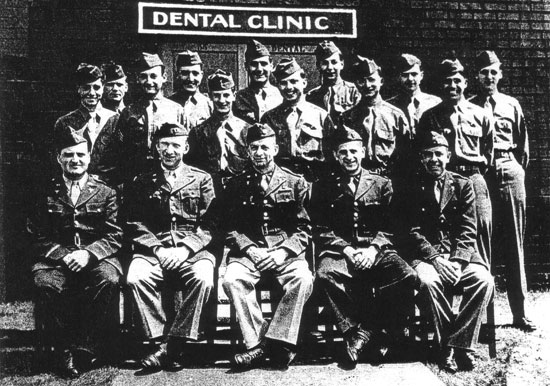
Dental Clinic personnel actually taken at Frenchay Park, Bristol.
The mortality of surgical cases was 0.34%, or 21 deaths in the 6034 surgical admissions. Of these deaths, 20 occurred on the Neurosurgical Section, with the majority suffering traumatic transverse myelitis plus severe associated lesions such as meningitis, intro-thoracic lesions, or sever compound fractures of the extremities.
In the five months directly proceeding the turn of 1945, a number of personnel changes were also conducted in other departments of the Hospital, most notably in the Dental clinic and also in the X-Ray departments.
Patient Rehabilitation:
The Rehabilitation Program was first set up under 1st Lt. William B. Hamilton and his staff. The two upper floors of the four-storey ward building were originally devoted to these patients. In March 1945 the men undergoing the program were moved into tents that had been set up outside. The patients were moved back into the large building with the final emptying of the Hospital, so that the tents could be taken down. The main purpose of the program was to get the men back into good physical condition and to reorient them into regular Army routine. To aid their physical recovery, the men were given calisthenics and graduated marches. Other activities were also encouraged, such as baseball, volleyball and other forms of sport.
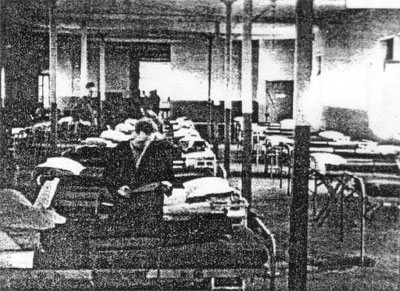
Patients of the 100th General Hospital convalesce in their wards at Bar-le-Duc at War’s end.
In May, the program was given over to 1st Lt. Guy A. Leonard and his assistant, S/Sgt Donald M. Reaume. Admissions and discharges from the program occurred three-weekly, so that there was a continual change of census in the department, generally ranging from 100 to 350 patients at any one time. A total of approximately 3500 men had been returned to duty via the Rehabilitation Section during its time in Bar-le-Duc.
Aftermath:
Upon War’s end, there was great jubilation, both inside the compound walls of the caserne and in the streets of Bar-le-Duc. After much celebration between the local population and the staff from the 100th General Hospital, it was back to work as normal at the complex. The patient population quickly evaporated, and the majority of the personnel, including the MAC Officers, Nurses and Doctors were sent to Redeployment Camps across the north coast of France. The Hospital was officially closed on 30 June 1945, having handled a total of 14,900 patients in its service overseas.
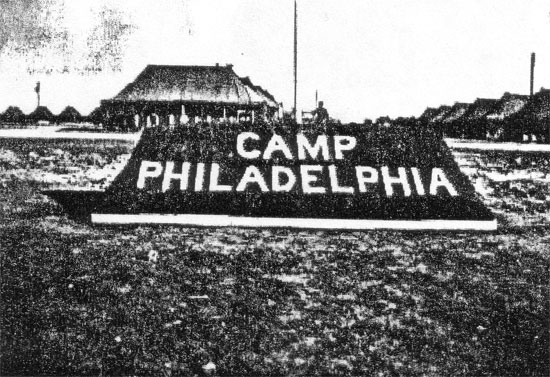
Camp Philadelphia located in the vicinity of Reims that acted as a Redeployment and Staging area for the 100th GH before its return to the United States.
Personnel of the unit that had accrued 85 points or more (under the Adjusted Service Rating Score) were transferred to one of the many “City Camps” that had been established for R&R purposes in France. The vast majority of personnel that had enlisted in the unit at Ft. Meade had sufficient points, and were transferred to ‘Camp Philadelphia’, a so-called tent city set up in the region of Reims.

Photograph showing members of the 100th General Hospital aboard the “Milwaukee” in the mid-Atlantic on 24 August 1945, returning to the ZI.
The unit remained in France for another month or so, finally departing French soil for the ZI on 20 August 1945 aboard a ship known only to the authors as “The Milwaukee”. The ship docked at New York harbor 43 days after the last light had been turned off at the hospital complex in Bar-le-Duc on 30 August 1945. A waiting convoy of trucks and buses shuttled what remained of the 100th General Hospital back to where it had departed from 511 days earlier; Cp. Kilmer, Stelton, New Jersey.
Uniform Regulations:
Enlisted Men:
-
- Class A Uniform:
- Cap, Garrison
- Coat, Service (where available)
- Decorations, service ribbons, badges and overseas bars as authorized
- Gloves (optional)
- Necktie, Khaki
- Shirt, O.D. or Khaki
- Shoes, Service
- Socks, Tan or Brown
- Trousers, Service
- Class A Uniform:
-
- Duty Uniform:
- Cap, Garrison
- Necktie, Khaki
- Shirt, Wool, O.D.
- Trousers, Service, Wool, O.D.
- Socks, Tan or Brown
- Shoes, Service (when combat or paratrooper boots are worn, the trousers will not be tucked in)
- Dog Tags are considered part of the uniform and must be worn at all times.
- Where appropriate, the Fatigue Uniform, Complete, will be worn. The wearing of mixed uniforms will be condoned.
- Duty Uniform:
- Athletic or Sports Uniform:
- When engaged in athletic games or sports, clothing appropriate to the game or sport may be worn.

General view showing the main entrance to the 100th General Hospital, Bar-le-Duc, France.
- When engaged in athletic games or sports, clothing appropriate to the game or sport may be worn.
Female Officers:
-
- Class A Uniform:
- Cap, Service, Wool, OD (interchangeable with Cap, Garrison)
- Jacket, Wool, OD, Women’s Nurses’ (except when waist without coat is authorized)
- Skirt, Wool, OD, Dark, Women’s Officer’s
- Waist, Cotton, Women’s (Khaki)
- Shoes, Service, Women’s, Low (Army Russet)
- Hosiery, Neutral Shade
- Gloves, Leather, Dress, Women’s (Army Russet) or Gloves, Wool, OD, Women’s
- OD Dress may be worn on or off the Post for social functions
- ATS Uniform is considered class A on the Post only.
- Class A Uniform:
-
- Duty Uniform:
- Seersucker Uniform will be worn while on duty at the Post.
- Dog Tags are considered part of the uniform and must be worn at all times.
- Duty Uniform:
- Athletic or Sports Uniform:
- When engaged in athletic games or sports, clothing appropriate to the game or sport may be worn.
Male Officers:
-
- Class A Uniform:
- Cap, Garrison
- Coat, Service or Eisenhower Jacket
* When the Eisenhower Jacket is worn, the collar insignia is required. Insignia will not be worn when the blouse is worn.
- Decorations, service ribbons, badges and overseas bars as authorized
- Gloves (optional)
- Necktie
- Shirt, OD or Khaki
- Shoes, Low Quarter (Army Russet)
- Socks, Plain Tan or Brown
- Trousers, Service (Green or Pink)
- Class A Uniform:
Class A Uniform will be worn when leaving the Post after 1700 hours.
-
- Duty Uniform:
- Cap, Garrison
- Shirt, Wool, OD (Green or Pink)
- Trousers, Wool, OD (Green or Pink)
- Necktie, Khaki
- Belt, Web, Waist
- Shoes, Service or Low Quarter (when combat or paratrooper boots are worn, the trousers will not be tucked in)
- Socks, Plain Tan or Brown
- The Eisenhower Jacket is optional for wear with the Duty Uniform
- Jacket, Field may be worn from the billet to the place of duty
- Dog Tags are considered part of the uniform and must be worn at all times.
- Duty Uniform:
- Athletic or Sports Uniform:
- When engaged in athletic games or sports, clothing appropriate to the game or sport may be worn.

Illustration showing the central supply and blood bank room of the 100th General Hospital. Photograph taken during the unit’s time at Bar-le-Duc, France.
- When engaged in athletic games or sports, clothing appropriate to the game or sport may be worn.
Roster
The following roster showing personnel of the 100th General Hospital was conducted on 16 June 1945:
| Officers | |
|---|---|
| Colonel: Maxwell, Charles L. Lieutenant Colonels: Majors: |
Dix, John W. Glenn, Samuel R. Grand, Nicholas G. Hand, Robert F. Hogue, William J. Howard, Richard C. Madison, Howard B. Rosensweig, Stanley H. Singler, John M. Spencer, Benjamin L. Stefani, Raymond T. Strange, Henry B. Sutta, Chester J. Weinberg, Julius Wolff, Adolph M. First Lieutenants: Second Lieutenants: |
| Nurses | |
| Second Lieutenants: Anderson, Wanda L. Bingen, Joann G. Blosser, Mary J. Brenner, Claire G. Bykle, Laura C. Carter, Margaret V. Cass, Eleanor J. Cooley, Faith E. Corrigan, Margaret T. Costello, Marjorie M. Crawford, Elizabeth R. Daume, Doris A. Davenport, Pearl P. De Lyle, Gloria E. Diesel, Evadna M. Du Mond, Arlene F. Duellman, Dolores C. Ehlke, Elizabeth G. Elliott, Esther R. Elvod, Lavon A. Gasser, Elsbeth A. Gibbons, Margaret A. Gould, Florence P. Gray, Elsie D. Halverson, Elda L. Heldt, Ruth E. Helgerson, Evelyn Herbes, Evelyn M. Janzen, Susan D. Jenney, Betty J. Johndro, Helen S. Johnston, Ona L. Johnston, Pauline G. Joyner, Lillian M. Kariolich, Frances D. Knoebel, Jean T. Kreger, Victoria A. Landt, Alice N. Langlois, Frances E. Lonergan, Helen S. Magnall, Ardell M. |
Miley, Martha A. Monk, Betty Jo Nayer, Mary A. Needham, Dorothy M. Nichols, Dorothy M. Oerichbauer, Elizabeth C. O’Konsky, Nancy J. Ott, Rose M. Pardowski, Irene M. Peterson, Charlotte C. Quinn, Doris T. Rademacher, Mary J. Roberts, Helen M. Rosenthal, Betty C. Sadowsky, Viola M. Sass, June L. Sawokin, Martha C. Schafer, Ethel C. Seelhorst, Elizabeth M. Sollien, Muriel K. Stewart, Frances D. Thom, Dorothy E. Underwood, Kathryn L. Vilmann, Alice D. Waterhouse, Viola J. Welch, Mary K. Wickens, Mary J. Hospital Dietitians (First Lieutenant): Physical Therapists (First Lieutenant): American Red Cross Workers: |

Exterior view of the 100th General Hospital, Bar-le-Duc, France.
| Enlisted Personnel | |
|---|---|
| Master Sergeants: Behringer, Charles W, Jr. Cornell, Marvin S. Rogers, Arthur J. First Sergeant: Technical Sergeants: Staff Sergeants: Technicians Third Grade: Sergeants: Technicians Fourth Grade: |
Schwarz, Basil W. Scocozza, Vito J. Scolaro, Joseph J. Shapiro, Isadore I. Siegel, Robert Sirotar, Adolf A. Socall, Harvey R. W. Sorrell, George C. Souza, William J. Stanford, Joseph E. Stebner, Harold P. Suick, Stephen A. Sweger, Richard W. Symbolic, John E. Thomas, John M. Van Bell, Maurice R. Vanelk, Joe, Jr. Vincent, Kenneth E. Woddington, Wallace M. White, John W. Wingot, Lynn O. Zonfrillo, Battesta J. Private First Class: |

Illustration showing a temporary ward at the 100th General Hospital’s facility at Bar-le-Duc, France.
| Corporals: Benesteel, Clyde E. Cordts, William F. Diller, Winford J. Gamblin, Stanley. Gates, Harold F. Haggerty, Andrew W, Jr. Lancaster, James L. Malek, John, Jr. Meredith, John W. Nitsch, Edward H. Peterson, Dewayne C. Reinschild, Carl Royer, William A. Sundell, Abner J. White, Edgar H. Technicians Fifth Grade: |
Perez, Joseph Pearson, James Pfeil, James H. Ploog, Edward T. Polen, David L. Portner, Lester L. Prough, Donald M. Prysner, John S. Quinn, William E. Quint, Matthew J. Reed, Lawrence T. Rego, Frank C. Reider, Sol Rice, Harold M. Ries, Henry O. Roberts, Antonio Roberts, James C. Robinson, Walter D. Rohr, Clarence V. Romano, Carl J. Roray, Raymond C, Jr. Rose, Mack Rothstein, Herbert Ruley, Louis R. Sarff, Dale B. Schruspki, Albert J. Schulemann, Calvin E. Schultz, James P. Sears, William E. Shwartz, Nathan. Simmons, Charles A. Simmons, Marcus B. Simons, Harry J. Sipo, Ray W. E. Sisson, Paul A. Smith, Percy Smith, Thomas E. Socha, Frank E. Soicher, Samuel Spain, Jack, Jr. Staecker, Vernon H. Starman, Frank J. Stewart, Thomas J. Stone, James B. Sutton, Jessie C. Tash, Abraham Tatro, Roland H, Jr. Taylor, Harry A. Teresiak, Stanley Tekavec, Frank A Tiner, Henry B. Tyler, Howard O. Ur, Joseph Vacula, John J. Valachi, Nicholas Van Kirk, William W. Wagner, Earl Wersosky, John M. White, Andrew J. White, Frederick, Sr. White, James F. Word, Curtis B. Privates: Alexander, Alex Armano, Ralph Bishop, Curtis L. Callahan, William M. Carnegie, Oran L. Cochran, Roy Eisaman, Vincent H. Fiore, Frank T. Gabrenya, Victor J. Carcia, Domingo R. Goodison, Alfred III Grandits, Peter A. Grudzien, John A. Jennings, Eugene C. Lange, William F. Leonard, Joseph L. Mitchell, Loyd E. Pritchard, Theodore E. Prokopiec, Myroslaw Ralston, Andrew J. Rhoads, Kenneth F. Rock, Peter A. Roybal, Gilbert Tenore, Michael |
The authors of this website would sincerely like to thank Pfc. Elmer K. Miller (ASN:35800394) who served with the 100th General Hospital EENT Clinic. Without his help, this Unit History would not have been possible and so our gratitude is certainly required here. In addition, unless otherwise stated, all of the photographs that appear on these pages belong to Elmer K. Miller.
